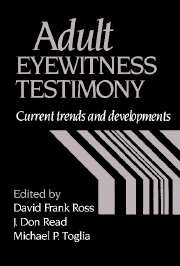Book contents
- Frontmatter
- Contents
- List of contributors
- Preface
- Part I Cognitive, physical and social processes and factors influencing eyewitness recall and identification
- 1 Reports of suggested memories: Do people truly believe them?
- 2 Memory source monitoring and eyewitness testimony
- 3 Understanding bystander misidentifications: The role of familiarity and contextual knowledge
- 4 Unconscious transference and lineup identification: Toward a memory blending approach
- 5 Earwitness evidence: Memory for a perpetrator's voice
- 6 Whole body information: Its relevance to eyewitnesses
- 7 Actual victims and witnesses to robbery and fraud: An archival analysis
- Part II Lineup construction and collection of testimony
- Part III Whom to believe? Distinguishing accurate from inaccurate eyewitnesses
- Name index
- Subject index
6 - Whole body information: Its relevance to eyewitnesses
Published online by Cambridge University Press: 04 August 2010
- Frontmatter
- Contents
- List of contributors
- Preface
- Part I Cognitive, physical and social processes and factors influencing eyewitness recall and identification
- 1 Reports of suggested memories: Do people truly believe them?
- 2 Memory source monitoring and eyewitness testimony
- 3 Understanding bystander misidentifications: The role of familiarity and contextual knowledge
- 4 Unconscious transference and lineup identification: Toward a memory blending approach
- 5 Earwitness evidence: Memory for a perpetrator's voice
- 6 Whole body information: Its relevance to eyewitnesses
- 7 Actual victims and witnesses to robbery and fraud: An archival analysis
- Part II Lineup construction and collection of testimony
- Part III Whom to believe? Distinguishing accurate from inaccurate eyewitnesses
- Name index
- Subject index
Summary
Introduction
During the past two decades, there has been a rapid increase in the number of psychological studies concerned with how we perceive and remember the human face (see Davies, Ellis, & Shepherd, 1981; Ellis, Jeeves, Newcombe, & Young, 1986; Shepherd, Ellis, & Davies, 1982; Young & Ellis, 1989, for reviews). This is perhaps unsurprising given the importance we attach to identifying other individuals and their emotions from facial information. What is surprising, however, is the relative lack of attention given to the role of nonfacial information such as body shape, dimension, and movement in person perception and recognition. The judgments we make about other people are often not based on facial information alone. Decisions such as whether a person is truthful or untruthful, happy or sad, sexy or unsexy appear to be based, at least in part, on nonfacial information (see, for example, Ekman, 1989; DePaulo & Kirkendol, 1989; Montepare & Zebrowitz-McArthur, 1988). It is also probable that general physical characteristics such as height and weight play a role in eyewitness identification (Wells, 1984), but there has been little systematic investigation of this issue.
The present chapter has two aims. The first is to review briefly the literature on the perception and recognition of body features. In doing so, we hope to point out the relevance of this work for eyewitness testimony. The second aim is to consider how nonfacial information could be incorporated into an identification system. We report on a series of studies we conducted which examine the potential of such a system. In particular, we will examine the kinds of descriptors typically used for bodies and movement, and the reliability of codings based on these descriptors.
- Type
- Chapter
- Information
- Adult Eyewitness TestimonyCurrent Trends and Developments, pp. 125 - 143Publisher: Cambridge University PressPrint publication year: 1994
- 17
- Cited by



